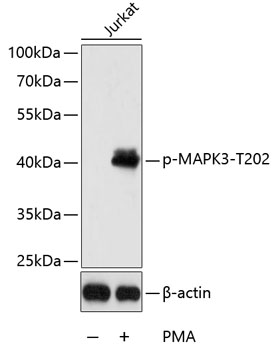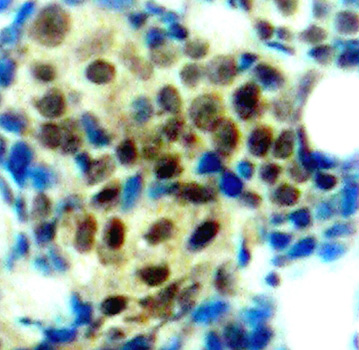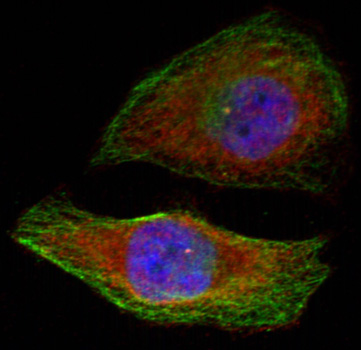Cell Death Antibodies 2
Anti-Phospho-MAPK3-T202 Antibody (CABP0234)
- SKU:
- CABP0234
- Product Type:
- Antibody
- Applications:
- WB
- Applications:
- IHC
- Applications:
- IF
- Reactivity:
- Human
- Reactivity:
- Mouse
- Reactivity:
- Rat
- Host Species:
- Rabbit
- Isotype:
- IgG
- Research Area:
- Cell Death
Description
| Antibody Name: | Anti-Phospho-MAPK3-T202 Antibody |
| Antibody SKU: | CABP0234 |
| Antibody Size: | 20uL, 50uL, 100uL |
| Application: | WB IHC IF |
| Reactivity: | Human, Mouse, Rat |
| Host Species: | Rabbit |
| Immunogen: | A phospho specific peptide corresponding to residues surrounding T202 of human MAPK3 |
| Application: | WB IHC IF |
| Recommended Dilution: | WB 1:500 - 1:2000 IHC 1:50 - 1:100 IF 1:100 - 1:200 |
| Reactivity: | Human, Mouse, Rat |
| Positive Samples: | Jurkat |
| Immunogen: | A phospho specific peptide corresponding to residues surrounding T202 of human MAPK3 |
| Purification Method: | Affinity purification |
| Storage Buffer: | Store at -20°C. Avoid freeze / thaw cycles. Buffer: PBS with 0.02% sodium azide, 50% glycerol, pH7.3. |
| Isotype: | IgG |
| Sequence: | Email for sequence |
| Gene ID: | 5595 |
| Uniprot: | P27361 |
| Cellular Location: | Cytoplasm, Nucleus |
| Calculated MW: | 38kDa/40kDa/43kDa |
| Observed MW: | 42kDa |
| Synonyms: | ERK-1, ERK1, ERT2, HS44KDAP, HUMKER1A, P44ERK1, P44MAPK, PRKM3, p44-ERK1, p44-MAPK, MAPK3 |
| Background: | The protein encoded by this gene is a member of the MAP kinase family. MAP kinases, also known as extracellular signal-regulated kinases (ERKs), act in a signaling cascade that regulates various cellular processes such as proliferation, differentiation, and cell cycle progression in response to a variety of extracellular signals. This kinase is activated by upstream kinases, resulting in its translocation to the nucleus where it phosphorylates nuclear targets. Alternatively spliced transcript variants encoding different protein isoforms have been described. |
| UniProt Protein Function: | ERK1: a serine/threonine kinase of the GMGC group that plays a critical role in the regulation of cell growth and differentiation. ERK1 (MAPK3) and ERK2 (MAPK1) play central roles in MAPK cascades and are activated by a wide variety of extracellular signals including growth and neurotrophic factors, cytokines, hormones and neurotransmitters. Depending on the cellular context, MAPK cascades mediate diverse biological functions such as cell growth, adhesion, survival and differentiation through the regulation of transcription, translation, cytoskeletal rearrangements. MAPK cascades also plays a role in initiation and regulation of meiosis, mitosis, and postmitotic functions in differentiated cells by phosphorylating a number of transcription factors. Activation of MAP kinases occurs through phosphorylation of threonine and tyrosine residues at the sequence T*EY* by upstream MAP kinase kinases, MEK1 and -2. Phosphorylation of both the threonine and tyrosine are required for activity. This phosphorylation causes dramatic conformational changes, which enable full activation and interaction of MAPK1/ERK2 with its substrates. |
| UniProt Protein Details: | Protein type:EC 2.7.11.24; Protein kinase, CMGC; Protein kinase, Ser/Thr (non-receptor); Kinase, protein; CMGC group; MAPK family; ERK subfamily; MAPK/ERK subfamily Chromosomal Location of Human Ortholog: 16p11.2 Cellular Component: microtubule cytoskeleton; nucleoplasm; Golgi apparatus; focal adhesion; cytoskeleton; mitochondrion; late endosome; early endosome; nuclear envelope; caveola; pseudopodium; nucleus; cytosol Molecular Function:MAP kinase activity; protein binding; phosphotyrosine binding; ATP binding; phosphatase binding Biological Process: axon guidance; DNA damage induced protein phosphorylation; activation of MAPKK activity; nerve growth factor receptor signaling pathway; positive regulation of histone phosphorylation; viral reproduction; apoptosis; activation of MAPK activity; stress-activated MAPK cascade; toll-like receptor 3 signaling pathway; sensory perception of pain; protein amino acid phosphorylation; toll-like receptor 10 signaling pathway; BMP signaling pathway; toll-like receptor 5 signaling pathway; response to exogenous dsRNA; regulation of transcription factor activity; small GTPase mediated signal transduction; lipopolysaccharide-mediated signaling pathway; toll-like receptor 4 signaling pathway; epidermal growth factor receptor signaling pathway; platelet activation; fibroblast growth factor receptor signaling pathway; cytokine and chemokine mediated signaling pathway; MyD88-independent toll-like receptor signaling pathway; MAPKKK cascade; transcription from RNA polymerase I promoter; cell cycle; toll-like receptor 2 signaling pathway; MyD88-dependent toll-like receptor signaling pathway; regulation of stress-activated MAPK cascade; organ morphogenesis; cartilage development; Ras protein signal transduction; toll-like receptor signaling pathway; insulin receptor signaling pathway; innate immune response; gene expression; positive regulation of histone acetylation; positive regulation of transcription from RNA polymerase II promoter; positive regulation of protein amino acid phosphorylation; toll-like receptor 9 signaling pathway; transcription initiation from RNA polymerase I promoter; vascular endothelial growth factor receptor signaling pathway; blood coagulation; phosphorylation; regulation of cytoskeleton organization and biogenesis |
| NCBI Summary: | The protein encoded by this gene is a member of the MAP kinase family. MAP kinases, also known as extracellular signal-regulated kinases (ERKs), act in a signaling cascade that regulates various cellular processes such as proliferation, differentiation, and cell cycle progression in response to a variety of extracellular signals. This kinase is activated by upstream kinases, resulting in its translocation to the nucleus where it phosphorylates nuclear targets. Alternatively spliced transcript variants encoding different protein isoforms have been described. [provided by RefSeq, Jul 2008] |
| UniProt Code: | P27361 |
| NCBI GenInfo Identifier: | 232066 |
| NCBI Gene ID: | 5595 |
| NCBI Accession: | P27361.4 |
| UniProt Secondary Accession: | P27361,Q8NHX1, A8CZ58, B0LPG3, |
| UniProt Related Accession: | P27361 |
| Molecular Weight: | 379 |
| NCBI Full Name: | Mitogen-activated protein kinase 3 |
| NCBI Synonym Full Names: | mitogen-activated protein kinase 3 |
| NCBI Official Symbol: | MAPK3 |
| NCBI Official Synonym Symbols: | ERK1; ERT2; ERK-1; PRKM3; P44ERK1; P44MAPK; HS44KDAP; HUMKER1A; p44-ERK1; p44-MAPK |
| NCBI Protein Information: | mitogen-activated protein kinase 3; MAPK 1; MAP kinase isoform p44; insulin-stimulated MAP2 kinase; extracellular signal-related kinase 1; extracellular signal-regulated kinase 1; microtubule-associated protein 2 kinase |
| UniProt Protein Name: | Mitogen-activated protein kinase 3 |
| UniProt Synonym Protein Names: | ERT2; Extracellular signal-regulated kinase 1; ERK-1; Insulin-stimulated MAP2 kinase; MAP kinase isoform p44; p44-MAPK; Microtubule-associated protein 2 kinase; p44-ERK1 |
| UniProt Gene Name: | MAPK3 |
| UniProt Entry Name: | MK03_HUMAN |









